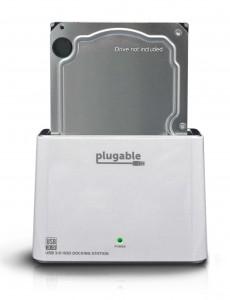
Q: Is this dock compatible with the Samsung 840 & 850 EVO series of SSDs?
A: No, the Samsung 840 & 850 EVO SSDs do not work with the ASM1051E chipset in this docking station. If you have a Samsung 840 or 850 EVO SSD, consider our newer USBC-SATA-V hard drive docking station instead.
Q: What size SATA drives are supported?
A: The latest firmware adds support for GPT (GUID Partition Table) format for compatibility with larger storage devices. We have tested with drives up to 6TB. Note that particular operating systems may have their own lower limits. For example, Windows XP limits drive size to 2TB.
Q: How should I insert drives?
A: Slide drives gently into the top of docking station bay, with SATA connectors aligned. Do not exert force. Drives will attach and rest on the SATA connector with the drive centered in the dock, cradled with space for airflow on all sides, so no fan is required. Drives are easily removed and reinserted with no cables or connectors to attach.
Q: What does the LED mean?
A: There is a single green LED on the front of the dock which will stay green as long as the device is powered and in active standby. During data transfer, the LED will blink rapidly. The green LED should turn off to indicate that the dock has powered down after a drive is ejected by the OS, however some USB hubs may cause the drive to stay in powered mode and the light to remain green with the drive powered even though the OS has safely disconnected the volume. A slightly slower blink indicates a sleeping drive. The same slower blink may indicate a faulty power supply. If your dock continues to blink green after waking the PC, turning the power switch on the back off and then back on again should resolve the issue.
Q: The green LED is not turning on when I have a drive inserted and AC power connected, but it does come on when I connect a USB cable. Is something wrong with my dock or power adapter?
A: The green power LED will only come on when all three of the following conditions are met:
- AC power is connected
- A drive is present
- There is a USB cable connecting the dock to a host PC
Q: My drive isn’t spinning up, even though the green power LED is on and I can see the docking station in Device Manager/System Information.
A: The SATA connector at the bottom of the dock likely isn’t lined up for the pins to connect: since the dock has a little “breathing room” it is possible to insert a drive where it seems to be fully seated but is in fact only sitting in the dock, and not really plugged in. Taking special care to line up the SATA connectors when inserting the disk can help avoid this.
Q: My drive is spinning, and detected in Disk Management/Disk Utility, however I get an error about needing to initialize the volume even though there is already data on my drive.
A: See this blog post on how to recover existing data.
Q: Do I need to update my firmware?
A: If you find that your drives are dismounting or disconnecting during use, or are not seeing drives sleep when your system sleeps, a firmware update should help. See here for firmware updates.
Q: How do I power the drive down when my computer is turned off or sleeping?
A: The Plugable USB3-SATA-U3 has a power switch that is used to power down the drive when not in use.
Q: My drive gets very hot to the touch during use.
A: Normally hard drives are typically inaccessible and inside of a PC or laptop’s fan-cooled environment. Many customers are not aware that hard drives will run very warm during use and that having a drive feel hot to the touch is normal, especially during heavy use such as during initial system backups or when cloning a disk. Typically hard drives will operate around 35-50C under load but should not exceed 60C or the internal SMART diagnostics may trip an over temperature alert. For further technical details, Google has published a detailed white paper that concludes “Failures do not increase when the average temperature increases. In fact, there is a clear trend showing that lower temperatures are associated with higher failure rates. Only at very high temperatures is there a slight reversal of this trend…”

